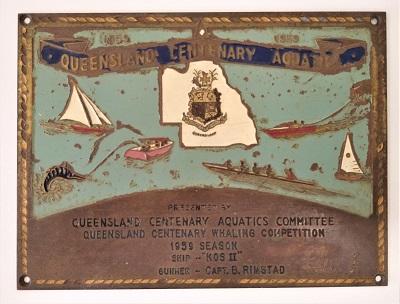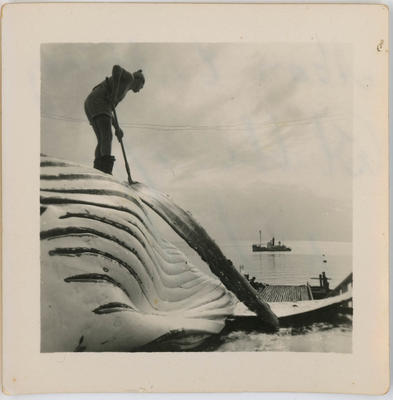Ernest Grant
Biography
Ern Grant was born in 1924, and began his career delivering telegrams in Brisbane on foot for the then G.P.O. He then began accounting before spending several years with the R.A.A.F., winding up an extremely senior Leading Aircraftsman.
While awaiting discharge at Sandgate in southern Brisbane, he was approached by a senior officer - a Flight Lieutenant at least - who said: "You have afforded a great deal of innocent amusement to us officers by digging worms in the C.O.'s garden, going through the wire, and fishing over the Sandgate flats. What're you going to do after discharge?"
Grant described his proposed return to the Public Service, where he would expect to spend his life waiting for dead men's shoes. But the Flight Lieutenant (at least) explained that Grant was eligible for University training: and why didn't he try for a career in fishing? So Grant went to Queensland University under the Commonwealth Rehabilitation Planning Scheme for ex-Servicemen and went on to take his B.Sc. and (much later) his M.Sc.
In 1955, he found a very narrow niche in the Queensland Public Service as a marine biologist; and worked in various Departments (Harbours & Marine; Mines; Co-ordinator-General) before becoming Deputy Director of the Queensland Fisheries Service. He then moved back to the Department of Harbours & Marine as Special Adviser in Marine Biology, where he remained until his "retirement" in 1984.
Since then, he has continued catching and photographing fish specimens and writing and producing books.Among the highlights of his career were-
* Introducing Government shark-fishing measures in 1962;
* Mounting a display of 1,840 hand-tinted corals for Expo '67 in Montreal;
* Observing first-hand the effects of crude oil spillage over a bed of living Great Barrier Reef coral. The coral appeared unaffected by the spills - a totally unexpected finding;
* Construction of a freshwater fish hatchery at Borumba in 1980;
* Production of the Government book: Guide to Fishes in its five steadily expanding editions from 1965 to 1982.
Because he was permitted to spend no more than 30% of his Government time working on these books, much of the work had to be done over weekends and during leave, assisted in no small capacity by late wife Meg and son Morgan - both of whom became effective fisheries technicians this way.Grant has always held a view that no-one can speak with authority about fish and marine life unless he has wet feet; and unless he can go into the field and catch fish himself.
A dedicated field worker, he has spent more than sixty years catching fish - and half that time photographing them. He still describes himself as a box-Brownie photographer. His wealth of experience gained through this work is partly manifested in Grant's narrative on many of the fish that he has caught - and photographed. He has had the privilege of working in a series of remote and beautiful locations, such as Lizard and Heron Islands in particular, and in the process, meeting many diverse people, both in the marine biology field and those who were not - but often in the same locations.
While awaiting discharge at Sandgate in southern Brisbane, he was approached by a senior officer - a Flight Lieutenant at least - who said: "You have afforded a great deal of innocent amusement to us officers by digging worms in the C.O.'s garden, going through the wire, and fishing over the Sandgate flats. What're you going to do after discharge?"
Grant described his proposed return to the Public Service, where he would expect to spend his life waiting for dead men's shoes. But the Flight Lieutenant (at least) explained that Grant was eligible for University training: and why didn't he try for a career in fishing? So Grant went to Queensland University under the Commonwealth Rehabilitation Planning Scheme for ex-Servicemen and went on to take his B.Sc. and (much later) his M.Sc.
In 1955, he found a very narrow niche in the Queensland Public Service as a marine biologist; and worked in various Departments (Harbours & Marine; Mines; Co-ordinator-General) before becoming Deputy Director of the Queensland Fisheries Service. He then moved back to the Department of Harbours & Marine as Special Adviser in Marine Biology, where he remained until his "retirement" in 1984.
Since then, he has continued catching and photographing fish specimens and writing and producing books.Among the highlights of his career were-
* Introducing Government shark-fishing measures in 1962;
* Mounting a display of 1,840 hand-tinted corals for Expo '67 in Montreal;
* Observing first-hand the effects of crude oil spillage over a bed of living Great Barrier Reef coral. The coral appeared unaffected by the spills - a totally unexpected finding;
* Construction of a freshwater fish hatchery at Borumba in 1980;
* Production of the Government book: Guide to Fishes in its five steadily expanding editions from 1965 to 1982.
Because he was permitted to spend no more than 30% of his Government time working on these books, much of the work had to be done over weekends and during leave, assisted in no small capacity by late wife Meg and son Morgan - both of whom became effective fisheries technicians this way.Grant has always held a view that no-one can speak with authority about fish and marine life unless he has wet feet; and unless he can go into the field and catch fish himself.
A dedicated field worker, he has spent more than sixty years catching fish - and half that time photographing them. He still describes himself as a box-Brownie photographer. His wealth of experience gained through this work is partly manifested in Grant's narrative on many of the fish that he has caught - and photographed. He has had the privilege of working in a series of remote and beautiful locations, such as Lizard and Heron Islands in particular, and in the process, meeting many diverse people, both in the marine biology field and those who were not - but often in the same locations.
Born/Established
b.1924














